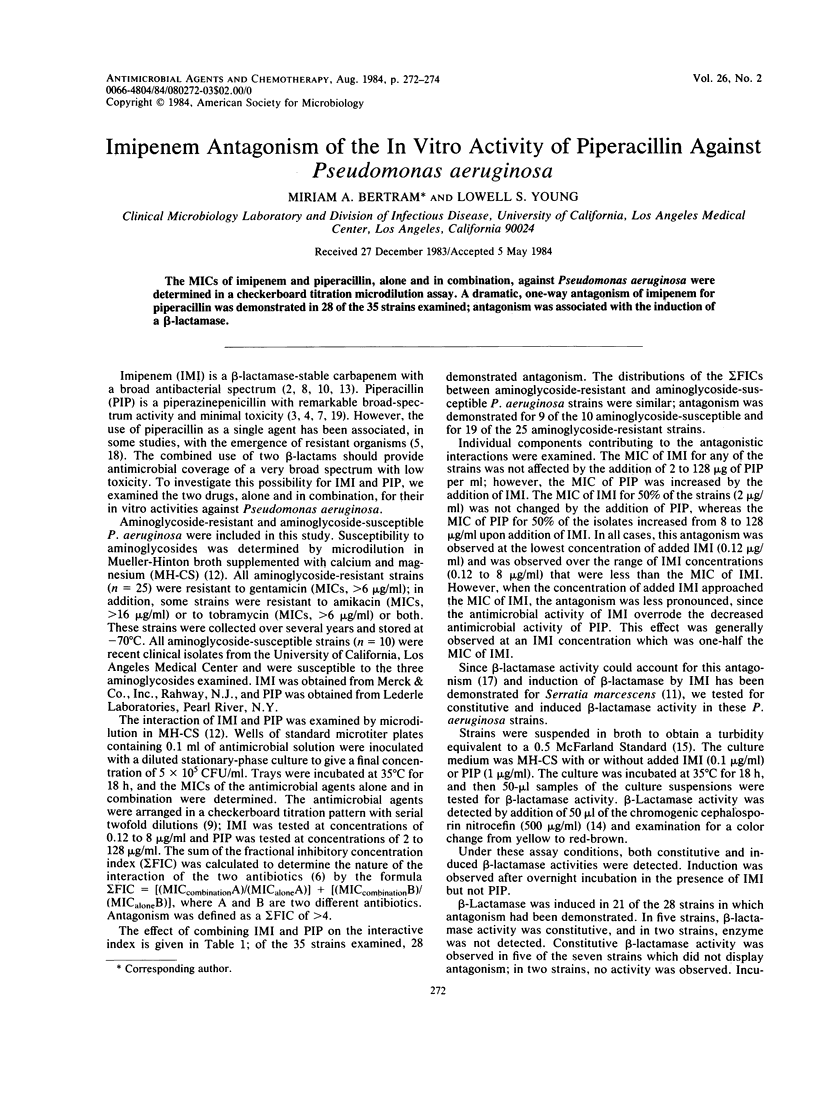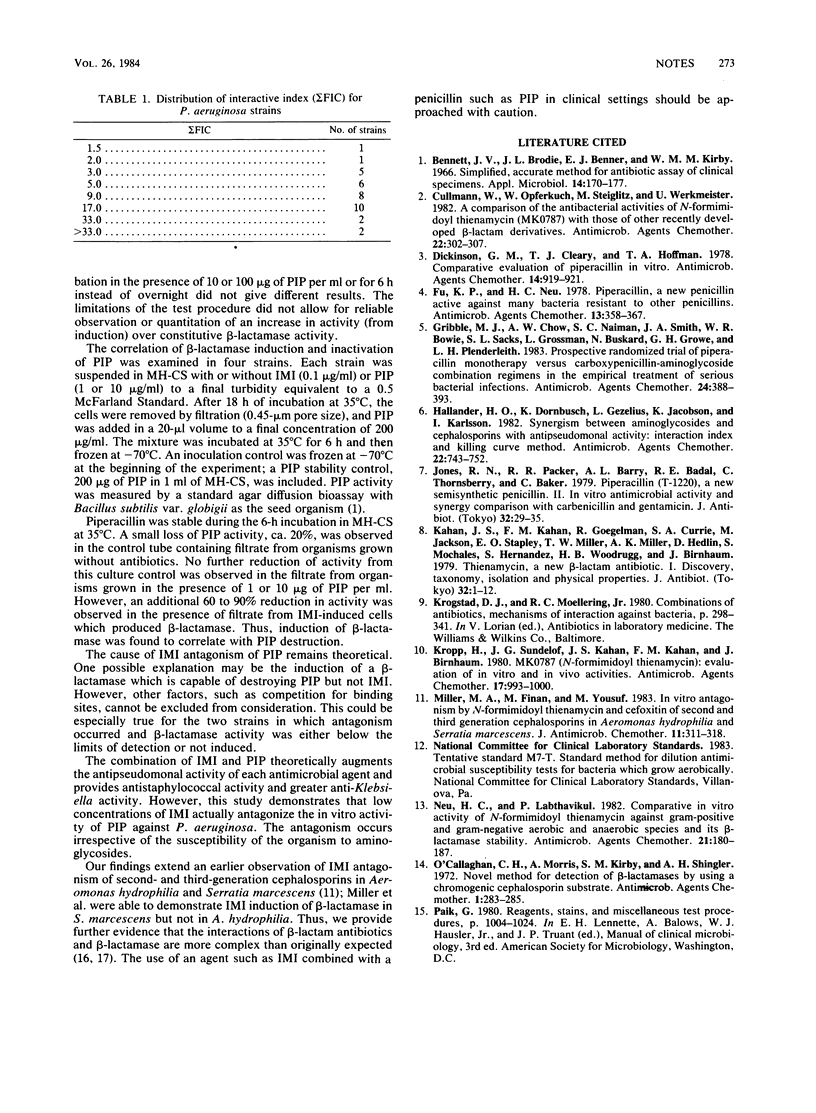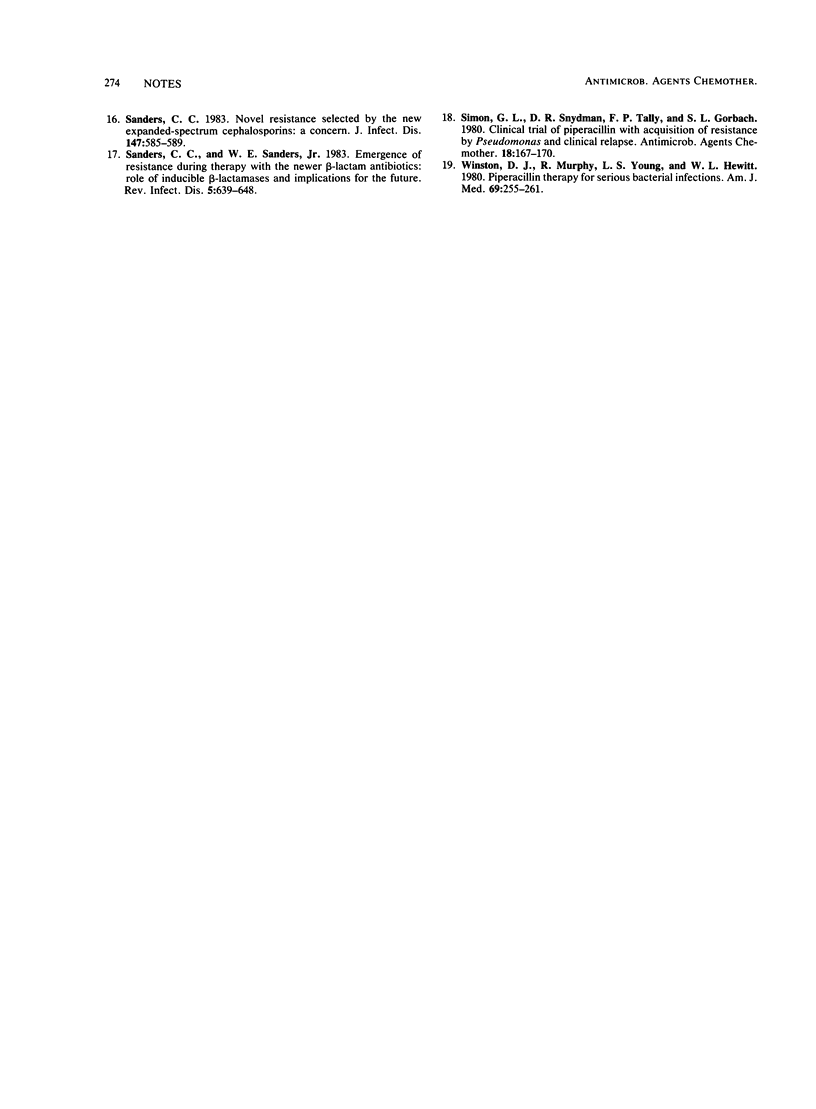Abstract
The MICs of imipenem and piperacillin, alone and in combination, against Pseudomonas aeruginosa were determined in a checkerboard titration microdilution assay. A dramatic, one-way antagonism of imipenem for piperacillin was demonstrated in 28 of the 35 strains examined; antagonism was associated with the induction of a beta-lactamase.
Full text
PDF


Selected References
These references are in PubMed. This may not be the complete list of references from this article.
- Bennett J. V., Brodie J. L., Benner E. J., Kirby W. M. Simplified, accurate method for antibiotic assay of clinical specimens. Appl Microbiol. 1966 Mar;14(2):170–177. doi: 10.1128/am.14.2.170-177.1966. [DOI] [PMC free article] [PubMed] [Google Scholar]
- Cullmann W., Opferkuch W., Stieglitz M., Werkmeister U. A comparison of the antibacterial activities of N-formimidoyl thienamycin (MK0787) with those of other recently developed beta-lactam derivatives. Antimicrob Agents Chemother. 1982 Aug;22(2):302–307. doi: 10.1128/aac.22.2.302. [DOI] [PMC free article] [PubMed] [Google Scholar]
- Dickinson G. M., Cleary T. J., Hoffman T. A. Comparative evaluation of piperacillin in vitro. Antimicrob Agents Chemother. 1978 Dec;14(6):919–921. doi: 10.1128/aac.14.6.919. [DOI] [PMC free article] [PubMed] [Google Scholar]
- Fu K. P., Neu H. C. Piperacillin, a new penicillin active against many bacteria resistant to other penicillins. Antimicrob Agents Chemother. 1978 Mar;13(3):358–367. doi: 10.1128/aac.13.3.358. [DOI] [PMC free article] [PubMed] [Google Scholar]
- Gribble M. J., Chow A. W., Naiman S. C., Smith J. A., Bowie W. R., Sacks S. L., Grossman L., Buskard N., Growe G. H., Plenderleith L. H. Prospective randomized trial of piperacillin monotherapy versus carboxypenicillin-aminoglycoside combination regimens in the empirical treatment of serious bacterial infections. Antimicrob Agents Chemother. 1983 Sep;24(3):388–393. doi: 10.1128/aac.24.3.388. [DOI] [PMC free article] [PubMed] [Google Scholar]
- Hallander H. O., Dornbusch K., Gezelius L., Jacobson K., Karlsson I. Synergism between aminoglycosides and cephalosporins with antipseudomonal activity: interaction index and killing curve method. Antimicrob Agents Chemother. 1982 Nov;22(5):743–752. doi: 10.1128/aac.22.5.743. [DOI] [PMC free article] [PubMed] [Google Scholar]
- Jones R. N., Packer R. R., Barry A. L., Badal R. E., Thornsberry C., Baker C. Piperacillin (T-1220), a new semisynthetic penicillin. II. In vitro antimicrobial activity and synergy comparison with carbenicillin and gentamicin. J Antibiot (Tokyo) 1979 Jan;32(1):29–35. doi: 10.7164/antibiotics.32.29. [DOI] [PubMed] [Google Scholar]
- Kahan J. S., Kahan F. M., Goegelman R., Currie S. A., Jackson M., Stapley E. O., Miller T. W., Miller A. K., Hendlin D., Mochales S. Thienamycin, a new beta-lactam antibiotic. I. Discovery, taxonomy, isolation and physical properties. J Antibiot (Tokyo) 1979 Jan;32(1):1–12. doi: 10.7164/antibiotics.32.1. [DOI] [PubMed] [Google Scholar]
- Kropp H., Sundelof J. G., Kahan J. S., Kahan F. M., Birnbaum J. MK0787 (N-formimidoyl thienamycin): evaluation of in vitro and in vivo activities. Antimicrob Agents Chemother. 1980 Jun;17(6):993–1000. doi: 10.1128/aac.17.6.993. [DOI] [PMC free article] [PubMed] [Google Scholar]
- Miller M. A., Finan M., Yousuf M. In-vitro antagonism by N-formimidoyl thienamycin and cefoxitin of second and third generation cephalosporins in Aeromonas hydrophila and Serratia marcescens. J Antimicrob Chemother. 1983 Apr;11(4):311–318. doi: 10.1093/jac/11.4.311. [DOI] [PubMed] [Google Scholar]
- Neu H. C., Labthavikul P. Comparative in vitro activity of N-formimidoyl thienamycin against gram-positive and gram-negative aerobic and anaerobic species and its beta-lactamase stability. Antimicrob Agents Chemother. 1982 Jan;21(1):180–187. doi: 10.1128/aac.21.1.180. [DOI] [PMC free article] [PubMed] [Google Scholar]
- O'Callaghan C. H., Morris A., Kirby S. M., Shingler A. H. Novel method for detection of beta-lactamases by using a chromogenic cephalosporin substrate. Antimicrob Agents Chemother. 1972 Apr;1(4):283–288. doi: 10.1128/aac.1.4.283. [DOI] [PMC free article] [PubMed] [Google Scholar]
- Sanders C. C. Novel resistance selected by the new expanded-spectrum cephalosporins: a concern. J Infect Dis. 1983 Mar;147(3):585–589. doi: 10.1093/infdis/147.3.585. [DOI] [PubMed] [Google Scholar]
- Sanders C. C., Sanders W. E., Jr Emergence of resistance during therapy with the newer beta-lactam antibiotics: role of inducible beta-lactamases and implications for the future. Rev Infect Dis. 1983 Jul-Aug;5(4):639–648. doi: 10.1093/clinids/5.4.639. [DOI] [PubMed] [Google Scholar]
- Simon G. L., Snydman D. R., Tally F. P., Gorbach S. L. Clinical trial of piperacillin with acquisition of resistance by Pseudomonas and clinical relapse. Antimicrob Agents Chemother. 1980 Jul;18(1):167–170. doi: 10.1128/aac.18.1.167. [DOI] [PMC free article] [PubMed] [Google Scholar]
- Winston D. J., Murphy W., Young L. S., Hewitt W. L. Piperacillin therapy for serious bacterial infections. Am J Med. 1980 Aug;69(2):255–261. doi: 10.1016/0002-9343(80)90386-1. [DOI] [PubMed] [Google Scholar]


